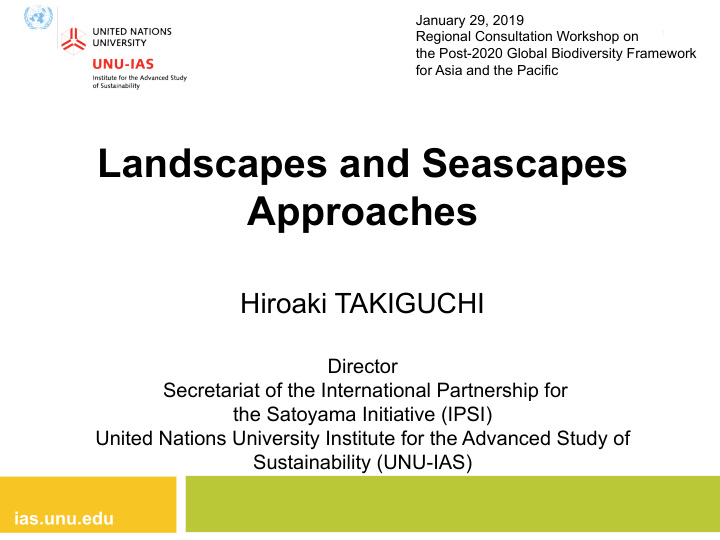



January 29, 2019 Regional Consultation Workshop on 1 the Post-2020 Global Biodiversity Framework for Asia and the Pacific Landscapes and Seascapes Approaches Hiroaki TAKIGUCHI Director Secretariat of the International Partnership for the Satoyama Initiative (IPSI) United Nations University Institute for the Advanced Study of Sustainability (UNU-IAS) ias.unu.edu
CBD objectives and the 2050 Vision CBD Article Article 1. Objectives The objectives of this Convention, to be pursued in accordance with its relevant provisions, are the conservation of biological diversity, the sustainable use of its components and the fair and equitable sharing of the benefits arising out of the utilization of genetic resources, including by appropriate access to genetic resources and by appropriate transfer of relevant technologies, taking into account all rights over those resources and to technologies, and by appropriate funding. The Strategic Plan for Biodiversity 2011-2020 and the Aichi Biodiversity Targets II. VISION The vision of this Strategic Plan is a world of “Living in harmony with nature” where “By 2050, biodiversity is valued, conserved, restored and wisely used, maintaining ecosystem services, sustaining a healthy planet and delivering benefits essential for all people.” 2
Socio-ecological Production Landscapes and Seascapes (SEPLS) ◼ Encompass most of the ecosystems in which biodiversity is located and which are actively used to serve human needs and development (ex. agricultural areas, places with forestry, fisheries, etc.) ◼ Can be managed well for biodiversity conservation through sustainable use, contributing to the 2nd objective of the Convention and the 2050 vision ◼ A form of “mainstreaming” of biodiversity into production sectors 3
Threats and Challenges Urbanization Over-exploitation Industrialized Abandonment agriculture 4
Landscapes and Seascapes Approaches ◼ Conservation approaches that act at the landscape or seascape scale as an integrated social-ecological system for its multi-functional mosaic of ecosystems and land uses rather than focusing on individual elements or sectors ◼ Consider the interests of all stakeholders appropriate to the local context. ◼ Recognized as effective for biodiversity conservation and sustainable use 5
The Satoyama Initiative • A global effort to realize “societies in harmony with nature” • Revitalization and sustainable management of landscapes and seascapes for people and nature CBD COP 10 Decision X/32: Sustainable use of biodiversity “ The Conference of the Parties, … Recognizes the Satoyama Initiative as a potentially useful tool to better understand and support human-influenced natural environments for the benefit of biodiversity and human well-being [ … ] and invites Parties, other Governments and relevant organizations to participate in the partnership to further advance the Initiative … ” q The International Partnership for the Satoyama Initiative (IPSI): a global platform to promote networking and collaboration on Socio-Ecological Production Landscape and Seascapes (SEPLS). UNU-IAS serves as IPSI Secretariat. 6
Lessons Learned from Case Studies ◼ Traditional knowledge for sustainable natural resource management contributes to establishing a positive relationship between humans and biodiversity. Ø Raising the awareness of communities on the relevance of traditional knowledge Ø Teachers’ capacity building to incorporate SEPLS-related issues in formal education ◼ Ensuring good governance and equity is essential for sustainable natural resource management. Ø Institutional coordination of different interests Ø Participatory decision-making and implementation Ø Community-based management of natural resources (Source) UNU-IAS and IGES (2015): Generating collective knowledge on the conservation, management and sustainable use of socio-ecological production landscapes and seascapes 7
Lessons Learned from Case Studies (cont’d) ◼ There is a need to identify and raise awareness about the values of landscapes and seascapes for their conservation or revitalization. Ø Demonstration of benefits from ecosystem services to the local people ◼ Sustainable biological resource use can be ensured through: Ø Development and application of various options to control overuse of biological resources Ø Cyclical use of natural resources in line with ecosystem functioning and human activity The most important lesson we have learned is: “Landscapes and seascapes approaches are effective for biodiversity conservation and sustainable use.” 8
Potential Thematic Consultation on Landscapes and Seascapes Approaches ◼ COP14 decided to encourage all relevant organizations to provide timely financial contributions and other support to the process for developing the post-2020 framework, including by offering to host global, regional, sectoral, or thematic consultations. ◼ Landscape and seascape approaches are one of the most relevant themes for thematic consultation. ◼ Tentative Plan: n Date: early September 2019 To be held back-to-back the 8 th IPSI Global Conference n Venue: Kumamoto, Japan One of the GIAHS (Globally Important Agricultural Heritage Systems) sites acknowledged by FAO n Discussion topics: (Photo) Association of Aso area world agriculture inheritance promotion ◼ Effectiveness of landscape and seascape approaches ◼ Elements for a Post-2020 Framework 9
Invitation to the Satoyama Initiative Side Event ◼ Theme: Multi-stakeholder partnership to enhance landscape and seascape approaches for biodiversity conservation and human livelihoods ◼ Date and Time: 18:30-20:00, January 29 ◼ Venue: Room 232 & 233, Building 2 ◼ Organizers: UNU-IAS, CI, IGES, MOEJ ◼ Programme: n Opening remarks (MOEJ) n Keynote Speech (Prof. Kazuhiko Takeuchi) n Research on NBSAPs (National Biodiversity Strategy and Action Plans) and landscape and seascape approaches (UNU-IAS) n Satoyama Development Mechanism (IGES) n GEF/Satoyama project (CI) n Discussion ◼ Refreshments will be served. 10
Recommend
More recommend